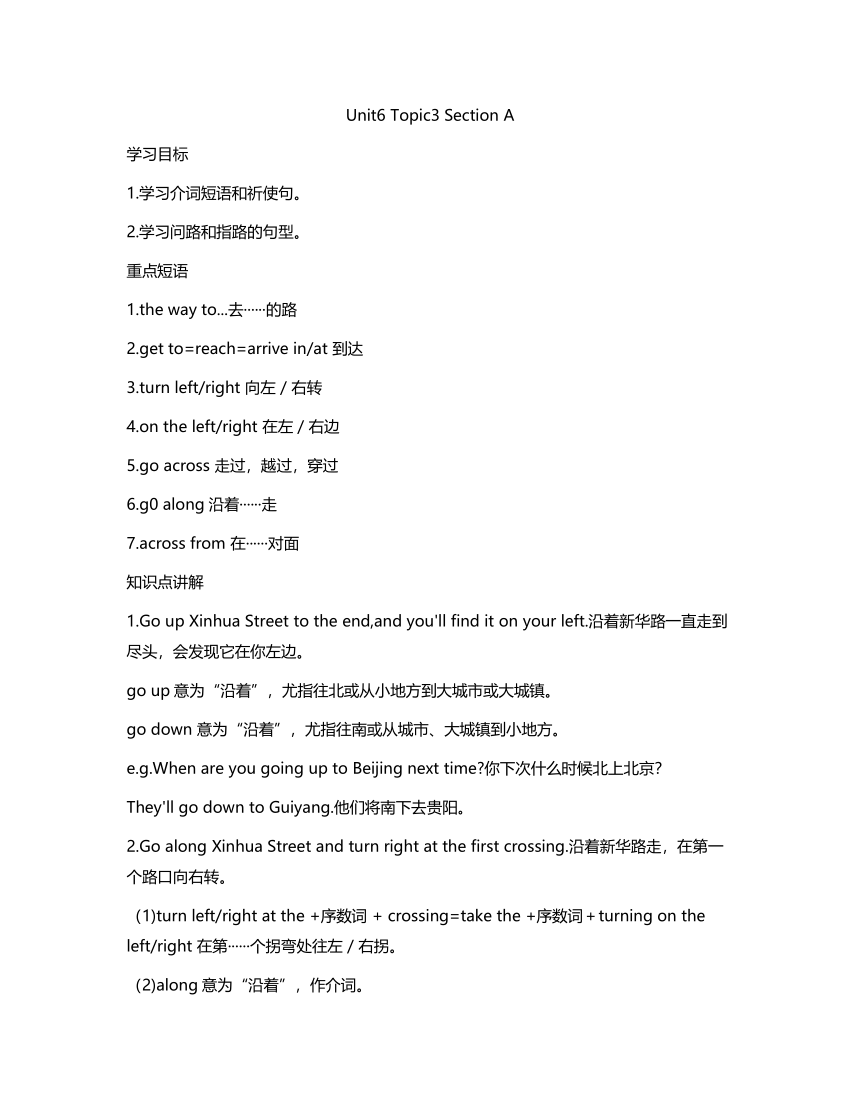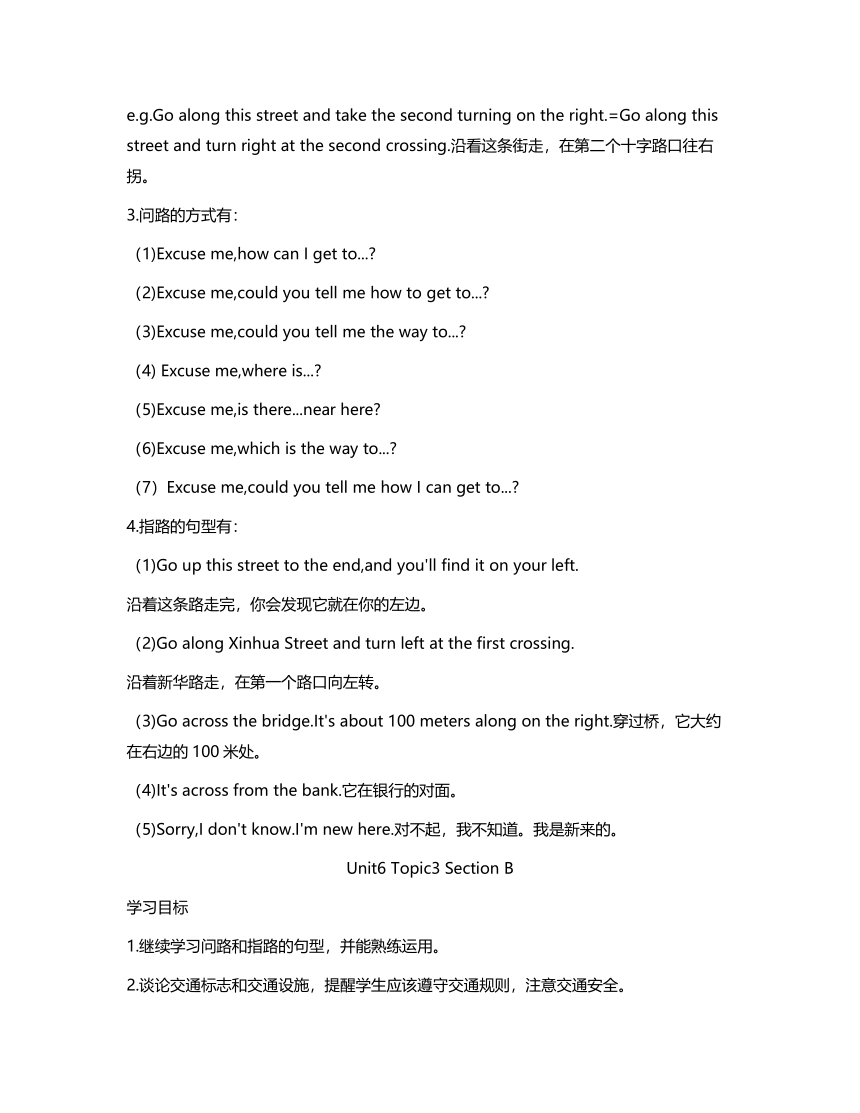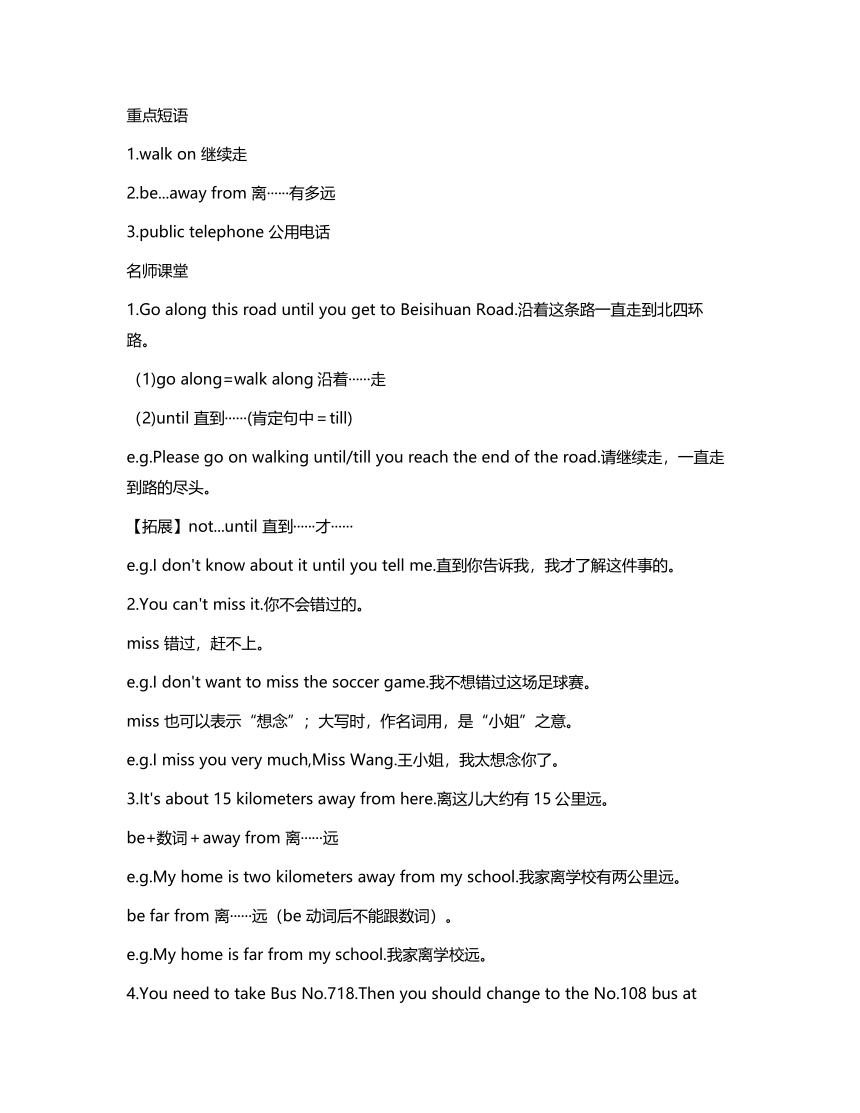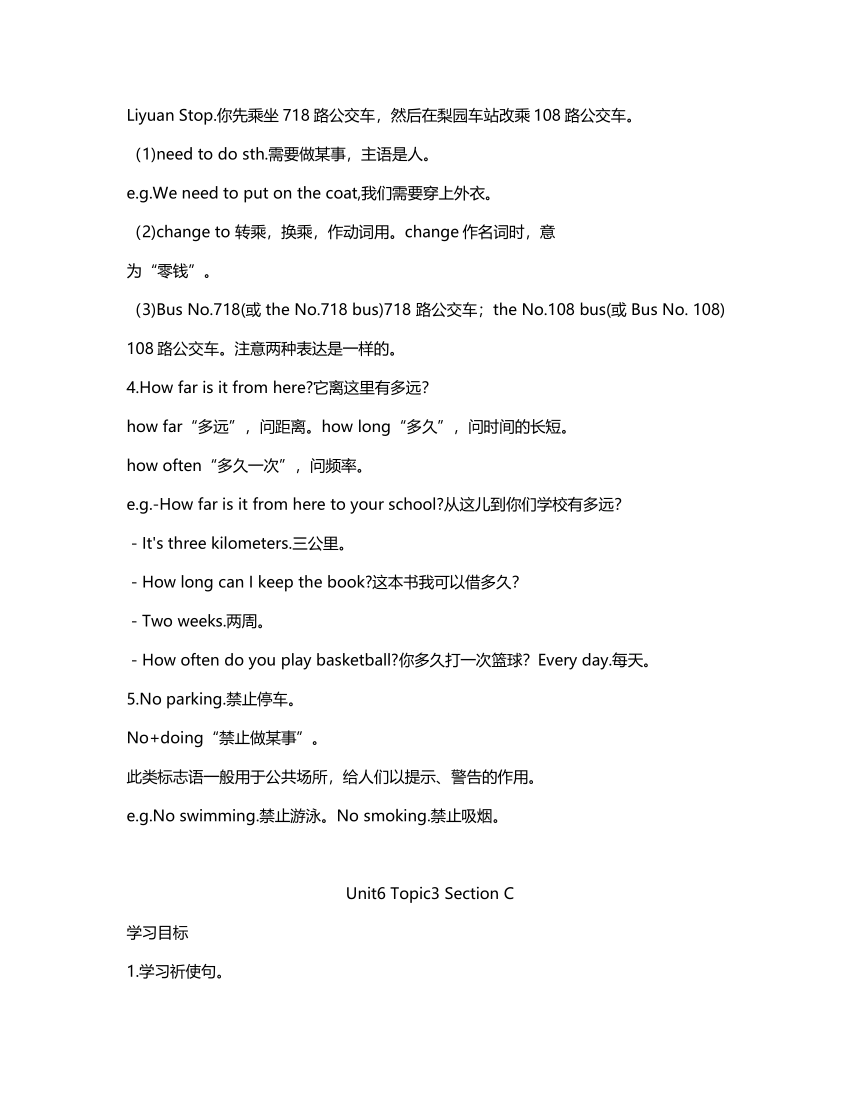仁爱版英语七年级下册Unit 6 Our local area Topic 3 Which is the way to the hospital?知识点归纳
文档属性
| 名称 | 仁爱版英语七年级下册Unit 6 Our local area Topic 3 Which is the way to the hospital?知识点归纳 |  | |
| 格式 | zip | ||
| 文件大小 | 31.2KB | ||
| 资源类型 | 教案 | ||
| 版本资源 | 仁爱科普版 | ||
| 科目 | 英语 | ||
| 更新时间 | 2020-06-05 16:44:22 | ||
图片预览




文档简介
Unit6
Topic3
Section
A
学习目标
1.学习介词短语和祈使句。
2.学习问路和指路的句型。
重点短语
1.the
way
to...去······的路
2.get
to=reach=arrive
in/at
到达
3.turn
left/right
向左/右转
4.on
the
left/right
在左/右边
5.go
across
走过,越过,穿过
6.g0
along沿着······走
7.across
from
在······对面
知识点讲解
1.Go
up
Xinhua
Street
to
the
end,and
you'll
find
it
on
your
left.沿着新华路一直走到尽头,会发现它在你左边。
go
up意为“沿着”,尤指往北或从小地方到大城市或大城镇。
go
down
意为“沿着”,尤指往南或从城市、大城镇到小地方。
e.g.When
are
you
going
up
to
Beijing
next
time?你下次什么时候北上北京?
They'll
go
down
to
Guiyang.他们将南下去贵阳。
2.Go
along
Xinhua
Street
and
turn
right
at
the
first
crossing.沿着新华路走,在第一个路口向右转。
(1)turn
left/right
at
the
+序数词
+
crossing=take
the
+序数词+turning
on
the
left/right
在第······个拐弯处往左/右拐。
(2)along意为“沿着”,作介词。
e.g.Go
along
this
street
and
take
the
second
turning
on
the
right.=Go
along
this
street
and
turn
right
at
the
second
crossing.沿看这条街走,在第二个十字路口往右拐。
3.问路的方式有:
(1)Excuse
me,how
can
I
get
to...?
(2)Excuse
me,could
you
tell
me
how
to
get
to...?
(3)Excuse
me,could
you
tell
me
the
way
to...?
(4)
Excuse
me,where
is...?
(5)Excuse
me,is
there...near
here?
(6)Excuse
me,which
is
the
way
to...?
(7)Excuse
me,could
you
tell
me
how
I
can
get
to...?
4.指路的句型有:
(1)Go
up
this
street
to
the
end,and
you'll
find
it
on
your
left.
沿着这条路走完,你会发现它就在你的左边。
(2)Go
along
Xinhua
Street
and
turn
left
at
the
first
crossing.
沿着新华路走,在第一个路口向左转。
(3)Go
across
the
bridge.It's
about
100
meters
along
on
the
right.穿过桥,它大约在右边的100米处。
(4)It's
across
from
the
bank.它在银行的对面。
(5)Sorry,I
don't
know.I'm
new
here.对不起,我不知道。我是新来的。
Unit6
Topic3
Section
B
学习目标
1.继续学习问路和指路的句型,并能熟练运用。
2.谈论交通标志和交通设施,提醒学生应该遵守交通规则,注意交通安全。
重点短语
1.walk
on
继续走
2.be...away
from
离······有多远
3.public
telephone
公用电话
名师课堂
1.Go
along
this
road
until
you
get
to
Beisihuan
Road.沿着这条路一直走到北四环路。
(1)go
along=walk
along沿着······走
(2)until
直到······(肯定句中=till)
e.g.Please
go
on
walking
until/till
you
reach
the
end
of
the
road.请继续走,一直走到路的尽头。
【拓展】not...until
直到······才······
e.g.I
don't
know
about
it
until
you
tell
me.直到你告诉我,我才了解这件事的。
2.You
can't
miss
it.你不会错过的。
miss
错过,赶不上。
e.g.I
don't
want
to
miss
the
soccer
game.我不想错过这场足球赛。
miss
也可以表示“想念”;大写时,作名词用,是“小姐”之意。
e.g.I
miss
you
very
much,Miss
Wang.王小姐,我太想念你了。
3.It's
about
15
kilometers
away
from
here.离这儿大约有15公里远。
be+数词+away
from
离······远
e.g.My
home
is
two
kilometers
away
from
my
school.我家离学校有两公里远。
be
far
from
离······远(be
动词后不能跟数词)。
e.g.My
home
is
far
from
my
school.我家离学校远。
4.You
need
to
take
Bus
No.718.Then
you
should
change
to
the
No.108
bus
at
Liyuan
Stop.你先乘坐718路公交车,然后在梨园车站改乘108路公交车。
(1)need
to
do
sth.需要做某事,主语是人。
e.g.We
need
to
put
on
the
coat,我们需要穿上外衣。
(2)change
to
转乘,换乘,作动词用。change作名词时,意
为“零钱”。
(3)Bus
No.718(或
the
No.718
bus)718
路公交车;the
No.108
bus(或
Bus
No.
108)
108路公交车。注意两种表达是一样的。
4.How
far
is
it
from
here?它离这里有多远?
how
far“多远”,问距离。how
long“多久”,问时间的长短。
how
often“多久一次”,问频率。
e.g.-How
far
is
it
from
here
to
your
school?从这儿到你们学校有多远?
-It's
three
kilometers.三公里。
-How
long
can
I
keep
the
book?这本书我可以借多久?
-Two
weeks.两周。
-How
often
do
you
play
basketball?你多久打一次篮球?Every
day.每天。
5.No
parking.禁止停车。
No+doing“禁止做某事”。
此类标志语一般用于公共场所,给人们以提示、警告的作用。
e.g.No
swimming.禁止游泳。No
smoking.禁止吸烟。
Unit6
Topic3
Section
C
学习目标
1.学习祈使句。
2.谈论交通规则,增强道路安全意识。
重点短语
1.keep
safe
保证安全
2.get
hurt
受伤
3.lose
one's
life
失去生命
4.a
ticket
for
doing
sth.一张的罚单
5.park
in
the
wrong
place
停错地点
6.make
a
wrong
turn转错弯
名师课堂
1.How
can
we
keep
safe
when
we
are
walking
on
the
street?当我们在街上行走时,怎么样才能保证安全呢?
(1)keep+adj.使······处于···(状态)
e.g.You
can
keep
warm
by
running
every
day.你每天可以通过跑步来取暖。
(2)when+一个句子(当······时候),引导一个表示时间的状语从句。
e.g.Please
bring
my
bag
when
you
come
to
my
home.当你来我家时,请给我把书包带来。
2.We
must
obey
the
traffic
rules.我们必须遵守交通规则。
(1)obey
the
rules
遵守规则
e.g.We
must
obey
the
school
rules
at
school.在学校,我们必须遵守校规。
(2)must
必须,情态动词,后跟动词原形,构成must
do
sth.必须做某事。
e.g-You
must
study
English
hard.你必须努力学英语。
(3)traffic
为不可数名词,意为“交通”。
3.Before
we
cross
the
street,we
must
stop
and
look
both
ways.在我们过马路之前,我们必须停下来,看两边。
(1)cross(=go
across)动词,意为“穿过,通过,渡过”。
The
old
woman
is
crossing
the
road.那位老奶奶正要过马路。
(2)cross还可用作名词,指“十字架”或“叉形记号”
4.It's
good
to
help
Children
and
old
people
cross
the
street,帮助小孩和老人过马路是一种助人为乐的行为。
It's
good
to
do
sth.做某事是好的,好心的。
It's
good
to
look
after
the
old
people.照顾老人是助人为乐的行为。
5.a
ticket
for
speeding
超速行驶罚单开同for连同其后的动名词作定语,修饰ticket;另外for
后也可接名词。
类似的表达有:a
ticket
for
drink-driving
酒驾罚款单;a
ticket
for
parking
in
the
wronging
place
乱停车罚单;a
ticket
for
making
a
turn拐错弯的罚单:a
ticket
for
lunch一张午餐券。
Unit6
Topic3
Section
D
学习目标
复习介词的用法;问路和指路的句型及祈使句。
语法链接:
一、祈使句
含义:是用来提出要求、建议或发出命令的句子。祈使句的主语通常为第二人称you(在实际应用中常常省略),谓语用动词原形,句尾用句号或感叹号。
常见的祈使句形式有:(1)肯定形式一般以动词原形开头。
e.g.Open
the
door,please.请开门。
(2)否定形式是在句首谓语动词前加don't.有时用never.
e.g.Don't
play
on
the
street.不要在街上玩。
(3)当说话对象是第一人称和第三人称,表示建议做某事时,通常用let来开头。
e.g.Let
me
put
it
up.让我把它挂起来吧。
(4)除了可以用谓语动词外,还可以用名词、形容词、副词等短语表示。
e.g.Quiet,please!请安静!
巧记祈使句的用法口诀
祈使句,有讲究,主语是you
不出头。
动词原形在句首,宾语随从跟在后。
表示请求与命令,直来直去不犯愁。
要想客气加please,句首句尾任遨游。
否定形式很简单,句首要把Don't添。
祈使句的肯定式:以动词原形开头,其否定式在句首加上Don't.
二、问路句型集中记
1.问路的常见句型:
(1)Excuse
me,is
there
a
bank
near
here?打扰一下,请问附近有银行吗?
(2)How
can
I
get
to
the
bookstore?请问我怎样才能去书店?
(3)Which
is
the
way
to
the
post
office?请问哪一条路去邮局?
(4)Could
you
tell
me
how
to
get
to...?你能告诉我怎样到达。·····?
(5)Where
is
the
post
office?邮局在哪里?
(6)Can
you
tell
me
the
way
to
the...?你能告诉我去·····.的路吗?
(7)Where
is
the
nearest...?请问最近的······在哪里?
(8)How
far
is
it
from
here?离这儿有多远?
2.常见的指路方法:
(1)Go
along
down
this
street.沿着这条街走。
(2)Go
straight
ahead.一直往前走。
(3)Turn
left
at
the
second
turning.在第二个拐弯处向左拐。
(4)Turn
right
at
the
first
crossing.在第一个十字路口向右拐。
(5)The
No.5
bus
can
take
you
to...5路公共汽车会带你到
(6)It's
about
one
hundred
meters
along/away.大约有100米远。
Topic3
Section
A
学习目标
1.学习介词短语和祈使句。
2.学习问路和指路的句型。
重点短语
1.the
way
to...去······的路
2.get
to=reach=arrive
in/at
到达
3.turn
left/right
向左/右转
4.on
the
left/right
在左/右边
5.go
across
走过,越过,穿过
6.g0
along沿着······走
7.across
from
在······对面
知识点讲解
1.Go
up
Xinhua
Street
to
the
end,and
you'll
find
it
on
your
left.沿着新华路一直走到尽头,会发现它在你左边。
go
up意为“沿着”,尤指往北或从小地方到大城市或大城镇。
go
down
意为“沿着”,尤指往南或从城市、大城镇到小地方。
e.g.When
are
you
going
up
to
Beijing
next
time?你下次什么时候北上北京?
They'll
go
down
to
Guiyang.他们将南下去贵阳。
2.Go
along
Xinhua
Street
and
turn
right
at
the
first
crossing.沿着新华路走,在第一个路口向右转。
(1)turn
left/right
at
the
+序数词
+
crossing=take
the
+序数词+turning
on
the
left/right
在第······个拐弯处往左/右拐。
(2)along意为“沿着”,作介词。
e.g.Go
along
this
street
and
take
the
second
turning
on
the
right.=Go
along
this
street
and
turn
right
at
the
second
crossing.沿看这条街走,在第二个十字路口往右拐。
3.问路的方式有:
(1)Excuse
me,how
can
I
get
to...?
(2)Excuse
me,could
you
tell
me
how
to
get
to...?
(3)Excuse
me,could
you
tell
me
the
way
to...?
(4)
Excuse
me,where
is...?
(5)Excuse
me,is
there...near
here?
(6)Excuse
me,which
is
the
way
to...?
(7)Excuse
me,could
you
tell
me
how
I
can
get
to...?
4.指路的句型有:
(1)Go
up
this
street
to
the
end,and
you'll
find
it
on
your
left.
沿着这条路走完,你会发现它就在你的左边。
(2)Go
along
Xinhua
Street
and
turn
left
at
the
first
crossing.
沿着新华路走,在第一个路口向左转。
(3)Go
across
the
bridge.It's
about
100
meters
along
on
the
right.穿过桥,它大约在右边的100米处。
(4)It's
across
from
the
bank.它在银行的对面。
(5)Sorry,I
don't
know.I'm
new
here.对不起,我不知道。我是新来的。
Unit6
Topic3
Section
B
学习目标
1.继续学习问路和指路的句型,并能熟练运用。
2.谈论交通标志和交通设施,提醒学生应该遵守交通规则,注意交通安全。
重点短语
1.walk
on
继续走
2.be...away
from
离······有多远
3.public
telephone
公用电话
名师课堂
1.Go
along
this
road
until
you
get
to
Beisihuan
Road.沿着这条路一直走到北四环路。
(1)go
along=walk
along沿着······走
(2)until
直到······(肯定句中=till)
e.g.Please
go
on
walking
until/till
you
reach
the
end
of
the
road.请继续走,一直走到路的尽头。
【拓展】not...until
直到······才······
e.g.I
don't
know
about
it
until
you
tell
me.直到你告诉我,我才了解这件事的。
2.You
can't
miss
it.你不会错过的。
miss
错过,赶不上。
e.g.I
don't
want
to
miss
the
soccer
game.我不想错过这场足球赛。
miss
也可以表示“想念”;大写时,作名词用,是“小姐”之意。
e.g.I
miss
you
very
much,Miss
Wang.王小姐,我太想念你了。
3.It's
about
15
kilometers
away
from
here.离这儿大约有15公里远。
be+数词+away
from
离······远
e.g.My
home
is
two
kilometers
away
from
my
school.我家离学校有两公里远。
be
far
from
离······远(be
动词后不能跟数词)。
e.g.My
home
is
far
from
my
school.我家离学校远。
4.You
need
to
take
Bus
No.718.Then
you
should
change
to
the
No.108
bus
at
Liyuan
Stop.你先乘坐718路公交车,然后在梨园车站改乘108路公交车。
(1)need
to
do
sth.需要做某事,主语是人。
e.g.We
need
to
put
on
the
coat,我们需要穿上外衣。
(2)change
to
转乘,换乘,作动词用。change作名词时,意
为“零钱”。
(3)Bus
No.718(或
the
No.718
bus)718
路公交车;the
No.108
bus(或
Bus
No.
108)
108路公交车。注意两种表达是一样的。
4.How
far
is
it
from
here?它离这里有多远?
how
far“多远”,问距离。how
long“多久”,问时间的长短。
how
often“多久一次”,问频率。
e.g.-How
far
is
it
from
here
to
your
school?从这儿到你们学校有多远?
-It's
three
kilometers.三公里。
-How
long
can
I
keep
the
book?这本书我可以借多久?
-Two
weeks.两周。
-How
often
do
you
play
basketball?你多久打一次篮球?Every
day.每天。
5.No
parking.禁止停车。
No+doing“禁止做某事”。
此类标志语一般用于公共场所,给人们以提示、警告的作用。
e.g.No
swimming.禁止游泳。No
smoking.禁止吸烟。
Unit6
Topic3
Section
C
学习目标
1.学习祈使句。
2.谈论交通规则,增强道路安全意识。
重点短语
1.keep
safe
保证安全
2.get
hurt
受伤
3.lose
one's
life
失去生命
4.a
ticket
for
doing
sth.一张的罚单
5.park
in
the
wrong
place
停错地点
6.make
a
wrong
turn转错弯
名师课堂
1.How
can
we
keep
safe
when
we
are
walking
on
the
street?当我们在街上行走时,怎么样才能保证安全呢?
(1)keep+adj.使······处于···(状态)
e.g.You
can
keep
warm
by
running
every
day.你每天可以通过跑步来取暖。
(2)when+一个句子(当······时候),引导一个表示时间的状语从句。
e.g.Please
bring
my
bag
when
you
come
to
my
home.当你来我家时,请给我把书包带来。
2.We
must
obey
the
traffic
rules.我们必须遵守交通规则。
(1)obey
the
rules
遵守规则
e.g.We
must
obey
the
school
rules
at
school.在学校,我们必须遵守校规。
(2)must
必须,情态动词,后跟动词原形,构成must
do
sth.必须做某事。
e.g-You
must
study
English
hard.你必须努力学英语。
(3)traffic
为不可数名词,意为“交通”。
3.Before
we
cross
the
street,we
must
stop
and
look
both
ways.在我们过马路之前,我们必须停下来,看两边。
(1)cross(=go
across)动词,意为“穿过,通过,渡过”。
The
old
woman
is
crossing
the
road.那位老奶奶正要过马路。
(2)cross还可用作名词,指“十字架”或“叉形记号”
4.It's
good
to
help
Children
and
old
people
cross
the
street,帮助小孩和老人过马路是一种助人为乐的行为。
It's
good
to
do
sth.做某事是好的,好心的。
It's
good
to
look
after
the
old
people.照顾老人是助人为乐的行为。
5.a
ticket
for
speeding
超速行驶罚单开同for连同其后的动名词作定语,修饰ticket;另外for
后也可接名词。
类似的表达有:a
ticket
for
drink-driving
酒驾罚款单;a
ticket
for
parking
in
the
wronging
place
乱停车罚单;a
ticket
for
making
a
turn拐错弯的罚单:a
ticket
for
lunch一张午餐券。
Unit6
Topic3
Section
D
学习目标
复习介词的用法;问路和指路的句型及祈使句。
语法链接:
一、祈使句
含义:是用来提出要求、建议或发出命令的句子。祈使句的主语通常为第二人称you(在实际应用中常常省略),谓语用动词原形,句尾用句号或感叹号。
常见的祈使句形式有:(1)肯定形式一般以动词原形开头。
e.g.Open
the
door,please.请开门。
(2)否定形式是在句首谓语动词前加don't.有时用never.
e.g.Don't
play
on
the
street.不要在街上玩。
(3)当说话对象是第一人称和第三人称,表示建议做某事时,通常用let来开头。
e.g.Let
me
put
it
up.让我把它挂起来吧。
(4)除了可以用谓语动词外,还可以用名词、形容词、副词等短语表示。
e.g.Quiet,please!请安静!
巧记祈使句的用法口诀
祈使句,有讲究,主语是you
不出头。
动词原形在句首,宾语随从跟在后。
表示请求与命令,直来直去不犯愁。
要想客气加please,句首句尾任遨游。
否定形式很简单,句首要把Don't添。
祈使句的肯定式:以动词原形开头,其否定式在句首加上Don't.
二、问路句型集中记
1.问路的常见句型:
(1)Excuse
me,is
there
a
bank
near
here?打扰一下,请问附近有银行吗?
(2)How
can
I
get
to
the
bookstore?请问我怎样才能去书店?
(3)Which
is
the
way
to
the
post
office?请问哪一条路去邮局?
(4)Could
you
tell
me
how
to
get
to...?你能告诉我怎样到达。·····?
(5)Where
is
the
post
office?邮局在哪里?
(6)Can
you
tell
me
the
way
to
the...?你能告诉我去·····.的路吗?
(7)Where
is
the
nearest...?请问最近的······在哪里?
(8)How
far
is
it
from
here?离这儿有多远?
2.常见的指路方法:
(1)Go
along
down
this
street.沿着这条街走。
(2)Go
straight
ahead.一直往前走。
(3)Turn
left
at
the
second
turning.在第二个拐弯处向左拐。
(4)Turn
right
at
the
first
crossing.在第一个十字路口向右拐。
(5)The
No.5
bus
can
take
you
to...5路公共汽车会带你到
(6)It's
about
one
hundred
meters
along/away.大约有100米远。
同课章节目录
- Unit 5 Our school life
- Topic 1 I usually come to school by subway.
- Topic 2 A few students are running around the play
- Topic 3 My school life is very interesting.
- Unit 6 Our local area
- Topic 1 Is there a computer in your study?
- Topic 2 My home is in an apartment building.
- Topic 3 Which is the way to the hospital?
- Review of Units 5-6
- Unit 7 The Birthday
- Topic 1 When is your birthday?
- Topic 2 Can you sing an English song?
- Topic 3 Everyone had a good time.
- Unit 8 The seasons and the Weathe
- Topic 1 What's the weather like in summer?
- Topic 2 The summer holidays are coming.
- Topic 3 Let’s celebrate!
- Review of Units 7-8
- 旧版资料
- Unit 5 Our School Life
- Unit 6 Our Local Area
- Unit 7 The Birthday
- Unit 8 The seasons and the Weathe
- Unit 7 Celebrating the Birthday(老版本)
